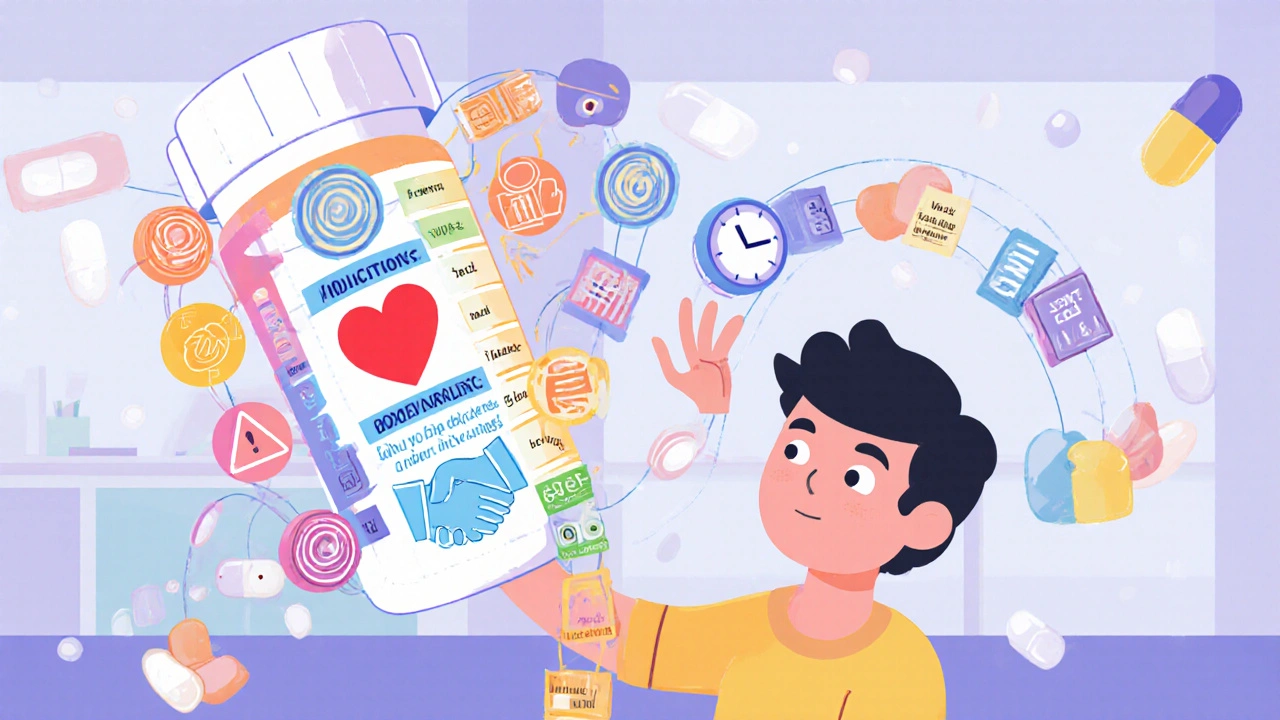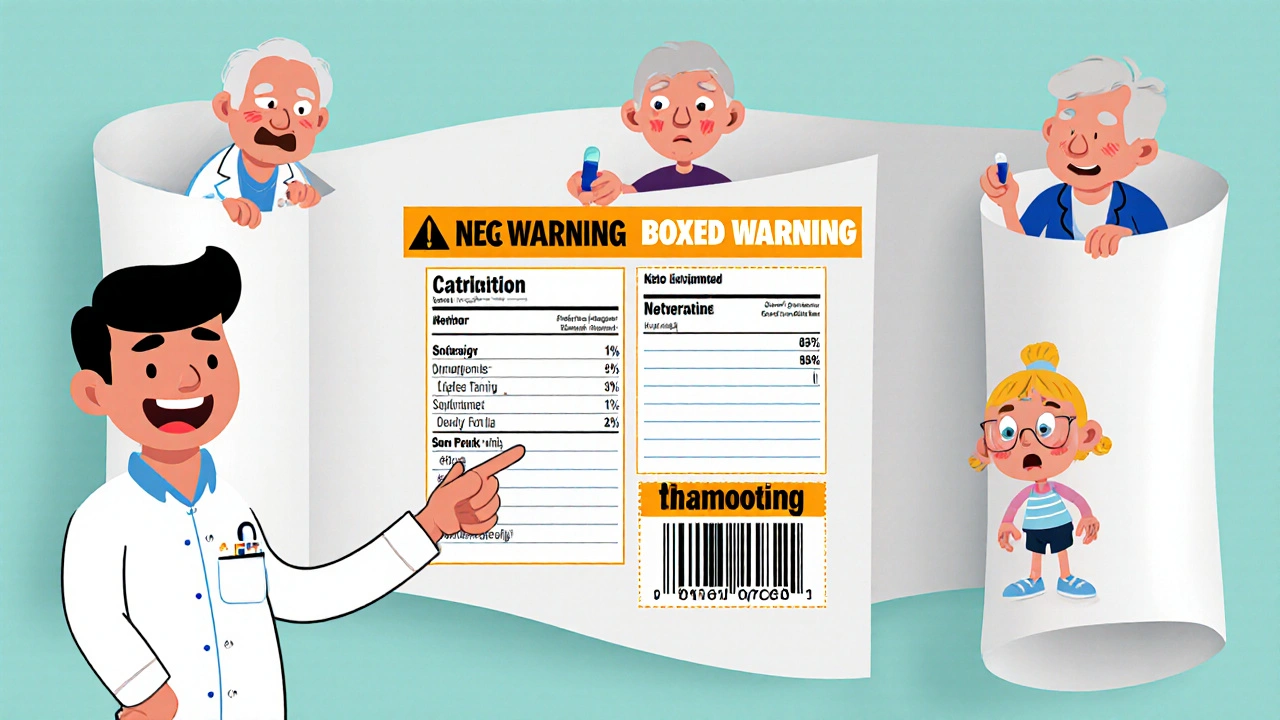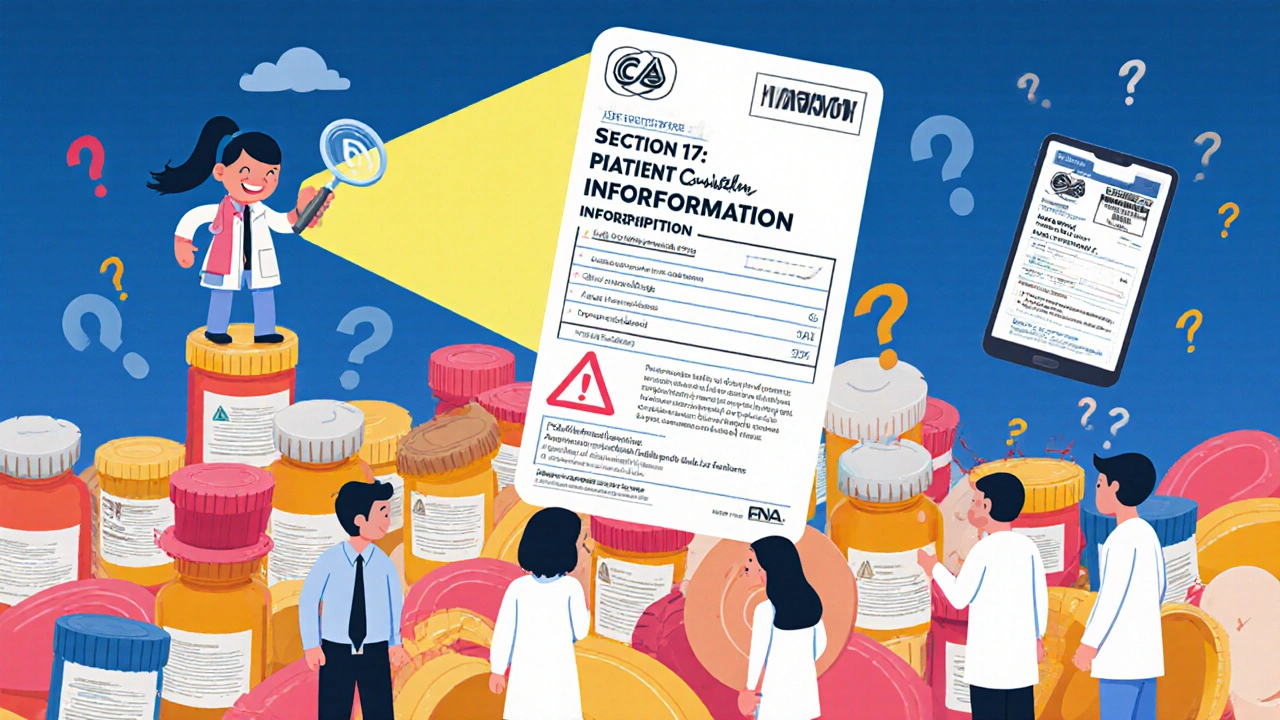
When you or a loved one gets a new prescription, the small paper label on the bottle is just the tip of the iceberg. Behind it lies a detailed, highly regulated document called the FDA drug label-a legal and clinical roadmap that tells doctors exactly how to use the medicine safely. Most people never see it. But if you’re a patient, caregiver, or healthcare worker, understanding this label can prevent serious mistakes, avoid dangerous interactions, and help you make smarter choices.
What Is the FDA Drug Label, Really?
The FDA drug label, officially called the United States Prescribing Information (USPI), isn’t just a suggestion. It’s the law. Every prescription drug sold in the U.S. must follow this exact format, set by the Food and Drug Administration under Title 21 of the Code of Federal Regulations. It’s created by the FDA’s Center for Drug Evaluation and Research (CDER) and updated regularly based on new safety data.
This label isn’t written for patients to read on their own-it’s designed for doctors, pharmacists, and other healthcare providers. But that doesn’t mean patients shouldn’t understand it. In fact, a 2024 study from the Inner Compass Initiative found that nearly 27% of patients who tried to learn about their meds using only the short summary on the bottle misunderstood the risks. That’s why knowing how to read the full label matters.
The Three Parts of the FDA Drug Label
The full FDA label has three main parts:
- Highlights of Prescribing Information - A half-page summary of the most critical info: what the drug treats, how to take it, serious risks, and side effects.
- Table of Contents - A numbered list of the 17 sections that follow.
- Full Prescribing Information (FPI) - The complete, detailed document with all 17 sections.
The Highlights section is meant to be quick-like a summary on the back of a medicine box. But here’s the catch: it says right on it that it’s incomplete. You must look at the Full Prescribing Information to get the full picture.
Section 1: Indications and Usage
This is where you find out what the drug is actually approved for. It’s not just "for high blood pressure." It says exactly which condition, in which patient group, and under what circumstances. For example, a drug might be approved for "hypertension in adults with type 2 diabetes," not just any high blood pressure.
Some labels also include the Established Pharmacologic Class (EPC)-a standardized phrase that tells you how the drug works in the body. Like "angiotensin II receptor blocker" or "selective serotonin reuptake inhibitor." This helps doctors compare drugs with similar actions.
Section 2: Dosage and Administration
This is where dosing gets specific. Not just "take one pill a day," but:
- How much to take for kidney problems
- How much to take for liver problems
- Whether to take it with food or on an empty stomach
- What to do if you miss a dose
- How to adjust for children or older adults
In March 2024, the FDA updated guidance here to make these instructions clearer-especially for patients with organ impairments. A 2023 Mayo Clinic study found that doctors spend nearly 5 minutes just reading this section during a visit. That’s how important it is.
Section 3: Dosage Forms and Strengths
Here you’ll see all the ways the drug comes: tablets, capsules, injections, liquids. And the exact strengths: 5 mg, 10 mg, 20 mg. This matters because pharmacies sometimes switch brands or generics, and the strength might change without you noticing.
Also listed here is the National Drug Code (NDC)-a 10-digit number broken into three parts: labeler code, product code, and packaging code. This is the drug’s fingerprint. It’s used by pharmacies, insurers, and the FDA to track every bottle sold.
Section 4: Contraindications
This section says: "Don’t use this drug if..." It’s black and white. For example:
- "Do not use if you have a known allergy to this drug or any of its ingredients."
- "Contraindicated in patients with severe liver disease."
- "Do not use with monoamine oxidase inhibitors (MAOIs)."
These are absolute no-gos. Ignoring contraindications can lead to life-threatening reactions. In 2023, the FDA issued 47 warning letters to drugmakers for missing or unclear contraindications in their labels.
Section 5: Warnings and Precautions (Including the Boxed Warning)
This is the most critical part for safety.
At the top, you’ll see a Boxed Warning-a thick black border around the most serious risks. These are the dangers that can cause death or permanent injury. For example:
- "Boxed Warning: Risk of severe liver injury."
- "Boxed Warning: Increased risk of suicidal thoughts in young adults."
Below that, you’ll find other warnings: risk of falls in the elderly, risk of kidney damage, risk of serotonin syndrome. These aren’t just side effects-they’re red flags that require monitoring.
Section 6: Adverse Reactions
This section lists side effects-but with a twist. It doesn’t just say "headache" or "nausea." It tells you how often they happened in clinical trials:
- Very common: >10% of patients
- Common: 1-10%
- Uncommon: 0.1-1%
- Rare: <0.1%
That helps you tell the difference between "this happens to most people" and "this almost never happens." For example, if a drug causes dizziness in 20% of users, you should expect it. But if it causes liver failure in 0.02%, that’s rare-and not something you need to lose sleep over.

Section 7: Drug Interactions
Drugs don’t work alone. This section tells you what else can go wrong when you take this medicine with other drugs, supplements, or even food.
It lists:
- Drugs that increase or decrease its effect
- Drugs that cause dangerous reactions when combined
- Food or alcohol interactions
For example, some blood thinners can’t be taken with St. John’s Wort. Some antibiotics make birth control pills useless. These aren’t "maybe" risks-they’re proven, documented interactions. In 2023, the Institute for Safe Medication Practices (ISMP) found that 12.7% of dispensing errors were caused by missed drug interactions.
Section 8: Use in Specific Populations
This section answers: "Is this safe for...?"
- Pregnant women
- Breastfeeding mothers
- Children
- Older adults
- People with certain ethnic backgrounds
For example: "Use with caution in patients over 65 due to increased risk of falls." Or: "No data available for use in children under 12." This is where you find out if the drug was even tested on your group.
Section 9: Drug Abuse and Dependence
Even if a drug isn’t a narcotic, it can still be misused. This section tells you if it has abuse potential, causes dependence, or leads to withdrawal symptoms.
For example, some antidepressants and sleep aids can cause withdrawal if stopped suddenly. Others may be attractive to people with substance use disorders. This info helps doctors decide whether to prescribe it-and how closely to monitor you.
Section 10: Overdosage
What happens if someone takes too much? This section lists symptoms and what to do. It’s not just "call 911." It says:
- What symptoms to watch for
- What tests doctors should run
- What treatments are used (like activated charcoal or antidotes)
Knowing this can save a life. In emergency rooms, time is everything. This section gives first responders and ER doctors the exact info they need.
Section 11: Description
This is the chemistry part. It gives the drug’s chemical name, structure, and molecular weight. Most patients won’t need this. But pharmacists and researchers use it to confirm the exact compound, especially when comparing generics.
Section 12: Clinical Pharmacology
This explains how the drug works in the body:
- How it’s absorbed
- How it’s broken down
- How it’s eliminated
- How long it lasts
For example: "Peak plasma concentration occurs in 2-4 hours after oral administration. Half-life is 12 hours." This helps doctors understand why they’re dosing it twice a day instead of once.
Section 13: Nonclinical Toxicology
This section has animal study data: cancer risk, gene damage, fertility effects. It’s not about what happens to you-it’s about what was seen in lab animals during testing. It’s mostly for regulators and scientists, but it can help explain why a drug has a Boxed Warning.

Section 14: Clinical Studies
This is where the evidence comes from. It summarizes the trials that proved the drug works. It tells you:
- How many people were studied
- How long the study lasted
- What the results were compared to placebo or other drugs
If you’re someone who wants to know if a drug was really tested on people like you, this is your section.
Section 15: References
Lists all the scientific papers and studies cited in the label. Useful if you want to dig deeper.
Section 16: How Supplied/Storage and Handling
This tells you:
- What the pill looks like (color, shape, imprint)
- How it’s packaged (bottle of 30, blister pack)
- Storage instructions (refrigerate? Keep away from light?)
- The NDC code again
Pharmacists use this to make sure they’re giving you the right drug. If your pill looks different this time, check this section. It could be a generic switch.
Section 17: Patient Counseling Information
This is the only section written for patients. It’s a list of talking points doctors and pharmacists should use when explaining the drug:
- "Take this with food to avoid stomach upset."
- "Do not drink alcohol while taking this medication."
- "Report any signs of unusual bleeding immediately."
Here’s the sad part: only 38.2% of providers actually use this section during patient visits, according to a 2024 audit. You can ask for it. Say: "Can you tell me what the FDA says I should know about this drug?" That’s your right.
Recent Major Changes
Since 2018, every FDA label must include this section. It lists every change made in the last six months. Did they add a new warning? Change the dose? Update the interaction list? This section tells you.
Experts say this has cut the delay between label updates and real-world use by 35%. If you’ve been on a drug for a while, check this section before your next refill. A new warning could be life-saving.
How to Use This Information
For patients:
- Don’t rely on the Highlights alone.
- Ask your pharmacist for the full label-or look it up online at FDA.gov.
- Pay attention to the Boxed Warning and Drug Interactions.
- Ask: "Does this drug have a different dose if I have kidney or liver problems?"
For caregivers:
- Keep a printed copy of the label next to the medicine.
- Write down the NDC number so you can track changes.
- Check the "Recent Major Changes" section every 6 months.
For healthcare providers:
- Always check the Boxed Warning first.
- Use Section 2 for dosing decisions.
- Review Section 7 before prescribing any new drug.
- Use Section 17 to guide patient conversations.
The Future of Drug Labels
The FDA is working on making labels more user-friendly. In 2024, they launched a pilot program with 15 drug companies testing interactive digital labels. Imagine clicking on a drug name in your EHR and seeing a pop-up with warnings, dosing tips, and patient instructions-all in plain language.
By 2027, most new drugs may come with these digital versions. But until then, the paper label is still the law. And understanding it? That’s your power.
Where can I find the full FDA drug label for my medication?
You can find the full FDA drug label on the FDA’s website at [email protected] or through the DailyMed database (dailymed.nlm.nih.gov). Simply search by the drug’s brand or generic name. The label is the same one your doctor and pharmacist use. You can also ask your pharmacist for a printed copy.
Is the information on the pill bottle the same as the FDA label?
No. The pill bottle label is a simplified version meant for quick reference. It includes your name, the drug name, dose, and instructions. The FDA label contains all the clinical, safety, and regulatory details-like contraindications, drug interactions, and boxed warnings-that aren’t on the bottle. Always check the full label for complete safety info.
What does a Boxed Warning mean for me?
A Boxed Warning means the drug carries a serious, potentially life-threatening risk. It could be liver damage, severe allergic reactions, or increased risk of suicide. This doesn’t mean you can’t take the drug-but it means you and your doctor need to be extra careful. You should be monitored closely, and you should know the warning signs. Never ignore a Boxed Warning.
Why does my generic drug look different than the brand name?
Generic drugs must have the same active ingredient, dose, and effect as the brand-but they can look different in color, shape, or imprint. That’s normal. Check Section 16 of the FDA label for the exact description of your pill’s appearance. If it doesn’t match, ask your pharmacist. It could be a different generic manufacturer.
Can I trust the side effects listed on the label?
Yes, but with context. The side effects listed are based on clinical trials with thousands of patients. They’re not guesses-they’re observed reactions. However, rare side effects (less than 0.1%) may not show up until the drug is used by millions of people. That’s why the FDA keeps updating labels. Always report any new or unusual symptoms to your doctor.
How often are FDA drug labels updated?
Labels are updated whenever new safety data becomes available. On average, a drug’s label changes every 14.3 months. The FDA requires manufacturers to report new risks within 30 days. The "Recent Major Changes" section at the top of the label tells you what’s new in the last six months. Always check it before refilling a long-term prescription.
What should I do if I think my drug label is wrong?
If you notice a clear error-like a wrong dose, missing warning, or outdated interaction-contact your pharmacist first. Then report it to the FDA through their MedWatch program (fda.gov/medwatch). You can file a report online or by phone. The FDA takes these reports seriously and investigates all claims of inaccurate labeling.
Final Thoughts
The FDA drug label isn’t just paperwork. It’s a safety net. It’s the difference between knowing what to watch for and being caught off guard. Whether you’re a patient, a caregiver, or a provider, knowing how to read it means you’re not just taking a pill-you’re making an informed decision.
Don’t wait for a mistake to happen. Open the label. Read the Boxed Warning. Check the interactions. Ask about the changes. That’s how you take control.
Comments (7)
-
sharicka holloway November 28, 2025
The FDA label is one of those things that feels like a secret code until you actually sit down and read it. I used to just glance at the bottle and assume I knew what I was taking-until my mom had a bad reaction because the pharmacist switched her generic, and the strength was different. Now I always pull up the full label online. It’s not glamorous, but it’s how you stay safe.
-
Shubham Semwal November 29, 2025
Most people don’t even know the label exists, let alone how to read it. And yet they’ll argue with their doctor about dosage like they’re an expert. The fact that 27% of patients misunderstand basic risks because they rely on the bottle summary? That’s not ignorance-it’s negligence. If you’re on a prescription, you owe it to yourself to read the full prescribing info. No excuses.
-
Sam HardcastleJIV November 30, 2025
It is, of course, an intriguing regulatory artifact-the United States Prescribing Information-as a formalized distillation of pharmacological authority. One cannot help but reflect upon the epistemological tension between the layperson’s desire for autonomy and the institutional imperative to control risk through linguistic precision. The Boxed Warning, in particular, functions as a semiotic monument to institutional caution.
-
Miriam Lohrum December 2, 2025
I’ve always thought it’s strange that the most critical information about what goes into your body is buried under layers of legal jargon, meant for professionals. Why isn’t there a plain-language version that’s equally enforceable? The FDA could easily create a parallel document-simple, accurate, and legally binding-for patients. It wouldn’t replace the label, but it would make safety accessible.
-
archana das December 2, 2025
In India, we don’t get these labels at all-just the name and dose on the packet. I remember my uncle taking a medicine for years because he thought it was for his back pain, but it was actually for nerve pain. He had no idea. This system in the U.S. is way better. Maybe we need to push for something like this where I’m from.
-
Emma Dovener December 3, 2025
Section 4, contraindications-this is where people die. I work in pharmacy, and I’ve seen patients ignore "do not use with MAOIs" because they thought it was just a "caution." One guy took an OTC cold med with his antidepressant and ended up in ICU. The label doesn’t sugarcoat. You need to take it seriously.
-
Jauregui Goudy December 5, 2025
THIS. IS. EVERYTHING. I used to think the bottle was enough-until my cousin had a seizure because she didn’t know the drug was contraindicated with her epilepsy meds. I spent weeks learning how to read the label. Now I print it out for every family member. If you’re taking something, you have a right-and a duty-to know what you’re putting in your body. Don’t let anyone tell you it’s too complicated. You’re smarter than you think.
